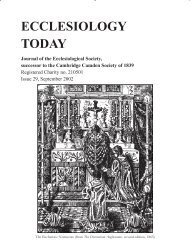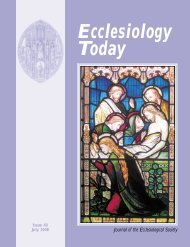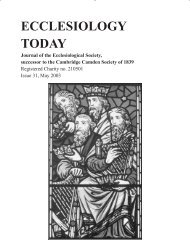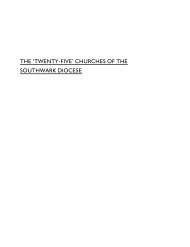PARISH CHURCHES? how do we keep our - Ecclesiological Society
PARISH CHURCHES? how do we keep our - Ecclesiological Society
PARISH CHURCHES? how do we keep our - Ecclesiological Society
Create successful ePaper yourself
Turn your PDF publications into a flip-book with our unique Google optimized e-Paper software.
DR SIMON THURLEY, CHIEF EXECUTIVE, ENGLISH HERITAGE • SPEECH 11<br />
Richard Giles wrote in 1999 in his in$uential book<br />
Re-pitching the Tent ‘the vast majority of <strong>our</strong> parish<br />
churches will require radical re-ordering to refurbish and<br />
re-equip them for service in the next century....<br />
re-ordering is a continuous process and not a one-off<br />
event’. Surely this must be true. Even looking at the<br />
post-Reformation history of parish worship <strong>our</strong> churches<br />
bear physical witness to Laudianism, Puritanism, the<br />
ecclesiological movement and evangelicalism, to name but<br />
a few. We cannot expect a congregation to have the same<br />
needs today as they did in the 1840s. Liturgy, like any<br />
other form of etiquette is always is a state of subtle change.<br />
Today’s ordering certainly<br />
wasn’t yesterday’s and is very<br />
unlikely to be tomorrow’s.<br />
Assuming <strong>we</strong> accept this<br />
assertion, what <strong>do</strong>es it mean<br />
for <strong>our</strong> most important<br />
churches? Well it means that<br />
<strong>we</strong> must act from an<br />
informed base. We must<br />
understand what <strong>we</strong> have<br />
and avoid s<strong>we</strong>eping it away<br />
in an attempt to<br />
accommodate the latest fad. There are big gaps in <strong>our</strong><br />
knowledge. Where are the most important interiors of the<br />
post-medieval period in particular? Just <strong>how</strong> many<br />
eighteenth-century box pews survive and where are the<br />
best furniture ensembles of the major nineteenth-century<br />
architects? To ans<strong>we</strong>r these sorts of questions <strong>we</strong> need<br />
research and I would like to know from you what you<br />
think <strong>our</strong> research priorities might be. We <strong>do</strong>n’t have<br />
endless res<strong>our</strong>ces – none of us has – but <strong>we</strong> want to use<br />
what <strong>we</strong> have in the way of money and staff to its greatest<br />
advantage.<br />
Flexibility like ‘reversibility’ has become something of a<br />
<strong>we</strong>asel word in conservation circles, implying that any<br />
change can be justi#ed. But it is the right word to describe<br />
an approach that is looking for creative solutions to<br />
managing change, which is what I want to see English<br />
Heritage <strong>do</strong>ing in its approach to the whole of the historic<br />
environment. We must continue to defend what should<br />
be defended with all the vig<strong>our</strong> and expertise <strong>we</strong> can<br />
muster and there are clearly some churches that can only<br />
tolerate very limited change. That should not mean that<br />
they are shunted into the Churches Conservation Trust as<br />
museums. We all must help them develop their own<br />
‘worship and mission’ to suit their circumstances. By<br />
re#ning the designation system and creating a wider range<br />
of management regimes in its wake, <strong>we</strong> might hope to<br />
avoid the con$ict that such cases often cause and promote<br />
the responsible use of historic churches. But this has to be<br />
<strong>do</strong>ne by us working together, on a strategic level, and not<br />
piecemeal as now.<br />
De#ning the signi#cant is also vitally important to the<br />
strategy that the Archbishops’ Council is embarking on in<br />
the next year or so. A Future for Church Buildings<br />
successfully demonstrates something that is perhaps<br />
obvious to all of us who are working with churches, that<br />
they are core buildings to their communities, for a<br />
There are so many examples<br />
already of <strong>how</strong> ‘saving’ a church<br />
on the brink of extinction can<br />
galvanise a community<br />
and re-vitalise its use<br />
wonderful variety of reasons. If they are not now, then<br />
they could be with a little vision and development. The<br />
care and conservation of churches has perhaps become too<br />
wrapped up in itself and needs to be integrated back into<br />
the mainstream of parish and diocesan life as a positive<br />
rather than a negative blocker of the ‘real’ work of the<br />
church. There are so many examples already of <strong>how</strong><br />
‘saving’ a church on the brink of extinction can galvanise a<br />
community and re-vitalise its use. What A Future for<br />
Church Buildings promotes is not just relevant to the care of<br />
historic churches, it is really about the re-establishment of<br />
church buildings into community life. That is where the<br />
churches started and that is<br />
<strong>how</strong> they must be perceived<br />
if they are to survive, and dare<br />
I say it, if the church in this<br />
country is to survive. And<br />
crucially church buildings are<br />
an important part of the<br />
mission of the church – the<br />
fact that they raise such<br />
heated debate amongst those<br />
wanting to be rid of them<br />
surely demonstrates that. It is<br />
going to be essential to change perceptions of the value of<br />
the church’s architectural heritage within parts of the<br />
church – though it will not be easy and will require a<br />
change in culture as <strong>we</strong>ll as widespread good examples.<br />
Secular authorities, especially those with money to<br />
spend on infrastructure like the Regional Development<br />
Agencies, need to be convinced that the projects they are<br />
being approached about really <strong>do</strong> bene#t everyone and are<br />
not simply helping a few. Remember that the Chancellor<br />
of the Exchequer, Gor<strong>do</strong>n Brown justi#ed the<br />
introduction of the scheme to refund VAT paid on church<br />
repairs with the argument that churches <strong>we</strong>re bene#ting<br />
their wider community and so should have greater help<br />
from the nation. It has to be said that the ecclesiastical<br />
exemption has, until quite recently, divorced churches<br />
from the community’s elected representatives in the local<br />
authorities. Politicians may be wary of interfering with<br />
religious matters, but the result of the exemption is that<br />
they and their staff in planning departments know far too<br />
little of the needs of parish churches. Churches might<br />
argue that their decisions are better than those made by<br />
local authorities, and made by people with a higher level<br />
of knowledge, but what chance <strong>do</strong> local authorities have to<br />
understand and participate in y<strong>our</strong> decisions, when they<br />
have been shut out of the process for so long? There are<br />
lots of good examples of co-operative working, and some<br />
of the case studies in the Synod paper demonstrate that.<br />
But the anti-local authority culture is still very prevalent<br />
within the churches, sometimes based on experience but<br />
too often based on perceptions that have gained their own<br />
momentum over the years. English Heritage also despairs<br />
of some decisions made by some local authorities, just as<br />
<strong>we</strong> despair of some decisions made by some DACs. But<br />
both systems have much to commend them, not least the<br />
enthusiasm of the devoted staff involved. English Heritage<br />
is in the position to act as an honest broker, to make you










